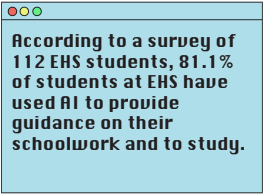Artificial intelligence (AI) is one of the most prevalent issues in education today. According to a poll conducted by The Stinger at EHS, 81 percent of students reported using AI to provide guidance on schoolwork or studying. Whether it be chatbots, image generation apps, or any of AI other capabilities, over 180 million people across the nation reported using the tool in 2023, and the number continues to grow, as stated by to the Pew Research Center.
Many varieties of AI have been major topics of discussion since they first emerged as viable tools. Debate around the ethical use of AI circulates around the globe daily, but one of the places it is most prevalent is in education. A Stinger poll showed 31 percent of students report using AI regularly to streamline their work process, brainstorm ideas, and in some cases, do full assignments for them.
The use of AI to create original products is known as generative AI, and some students utilize it to complete tasks such as essays for them. While using generative AI may be convenient, it can have an overall negative impact on the user.
“It’s obvious that the writing is not their own [when AI generates it]” English Department Chair Justine Frantzen said. “I wish students had the confidence to see that writing is a process…relying on a computer to do the work for you, it’s just detrimental in the long run.”
The use of AI in the East Penn School District has been heavily debated. One of the most prevalent topics being argued is the safety concerns that come with AI.

“We did put in place a[n]…AI in education policy that was adopted by the school board…which includes…AI literacy [and] learning about AI,” Director of Technology for EPSD Michael Billman stated.
EHS recently adopted policy 815.1 on the use of AI, which provides guidelines on how staff and students should teach and utilize AI respectively.
Despite the control on an administrative level, most of the decisions on how AI is used is left up to the individual educators in the classroom.
“The use of AI being in discretion with the teacher to decide, based on assignments… whether or not…it’s okay for use within part of an assignment or not using AI at all,” Billman stated.
The use of generative AI is one of the primary concerns among those questioning the ethics of using AI. Students have the opportunity to dodge work by simply using the AI tools at their disposal to complete the work for them. However, using AI in other ways can greatly benefit students.
“I’ve actually been able to see [the use of AI] at all three levels so far, which was really exciting,” K-12 Technology Coach for East Penn Dylan Peters said. “At our elementary school I was able to see them utilizing school AI in a chatbot format to help. The middle level…students were using it to…brainstorm ideas for what they were going to write.”

Teachers are also able to benefit from AI in their classrooms. They are currently undergoing a training program to teach them how to use AI responsibly and how to help their students do the same.
“A teacher can use something called Magic Write…which is powered by ChatGPT…to come up with a template based on what they’re designing,” Peters said.
Artificial intelligence can be used to streamline work inside and outside the classroom. Peters himself uses it in his career to save time and do work more efficiently.
“I use a lot of CanvaAI and I use ChatGPT a ton for different things, whether that’s writing lesson plans, coming up with project ideas, [or] developing slide decks,” Peters said. “It used to take me hours to come up with a slide deck that I liked…I can now do that in a couple of seconds.”
Peters is not the only staff member to use AI to help complete work.
“I use AI for all different things,” Billman said. “Some of the tools we use in the technology department has AI built into it.”
The use of AI in our schools may be new and somewhat misunderstood, but the policies are constantly being changed to better the use and understanding of AI and the role it should play in school. By using AI, educators and students can speed up the mundane aspects of education and focus on connecting with others.
“We’ve got to use [AI] intelligently, responsibly, effectively, [and] efficiently. That human-to-human interaction should come back and more,” Peters said.






